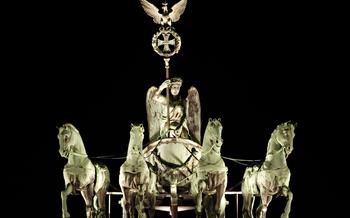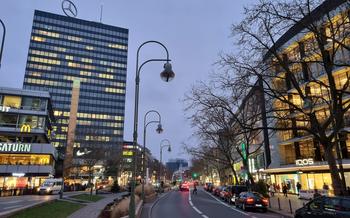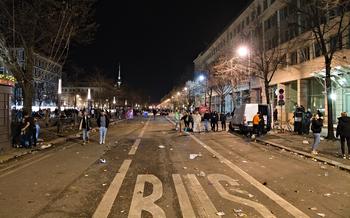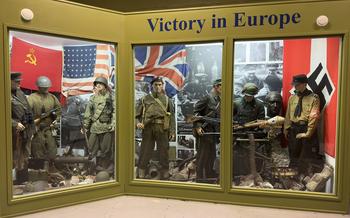
The Flak Towers at Humboldthain Park
- The Flak Towers at Humboldthain Park
- Surviving Remnant of World War II
- A Walk Through History
- Exploring the Flakturm IV Humboldthain
- Panoramic Views from the Observation Deck
- Humboldthain Park's Natural Beauty
- The Bunker Museum: A Journey Through History
- Exploring the Underground Tunnels
- Memorial for the Victims of War
- Street Art and Graffiti: A Vibrant Canvas of Urban Expression
- Events and Exhibitions
- Accessibility and Transportation
- Opening Hours and Admission
- Photography and Videography
- Insider Tip: Unraveling Hidden Secrets
The Flak Towers at Humboldthain Park
Amidst the tranquil greenery of Humboldthain Park in Berlin stands a stark reminder of a tumultuous past—the Flakturm IV Humboldthain. Constructed during World War II as part of a network of flak towers designed to protect the city from Allied air raids, this imposing structure has undergone a remarkable transformation, emerging as a symbol of remembrance and a testament to the resilience of the human spirit.
The Flakturm IV Humboldthain, also known as the Humboldthain Tower, stands as a silent sentinel, bearing witness to the horrors of war and the indomitable will to rebuild and reconcile. Its imposing presence serves as a poignant reminder of the devastating conflict that once engulfed Europe, while its current incarnation as an urban oasis offers a sanctuary for contemplation and reflection.
As visitors explore the tower's labyrinthine interior, they are confronted with preserved wartime graffiti and inscriptions, providing a glimpse into the lives of those who sought refuge within its walls during the relentless air raids. These poignant etchings, left behind by ordinary people facing extraordinary circumstances, evoke a sense of empathy and connection to the past.
Today, the Flakturm IV Humboldthain stands not only as a relic of war but also as a symbol of hope and renewal. Its transformation into an urban oasis, complete with lush greenery and serene walking trails, offers a stark contrast to its former role as an instrument of destruction. The park's tranquil atmosphere invites visitors to pause, reflect, and remember the countless lives lost during the war, while also celebrating the enduring power of peace and reconciliation.
Surviving Remnant of World War II
During the tumultuous years of World War II, Germany embarked on an ambitious construction project that resulted in the creation of several flak towers, massive structures designed to serve as air defense fortresses. These imposing towers, including the Flakturm IV Humboldthain, were a testament to the country's determination to safeguard its cities from enemy air raids.
The flak towers were not mere fortifications; they represented a significant engineering feat. Their colossal size and innovative design made them architectural marvels of their time. Constructed using reinforced concrete, these towers could withstand the impact of bombs and the intense heat of explosions. Their thick walls and multiple layers provided protection for the anti-aircraft guns and the thousands of civilians who sought refuge within their walls.
Historical photographs and anecdotes from the war paint a vivid picture of the flak towers' role in the defense of Berlin. These structures became a symbol of resilience and defiance, standing tall amidst the ruins of a city ravaged by war. They served as a sanctuary for those seeking shelter from the relentless air raids, offering a glimmer of hope in the face of devastation.
A Walk Through History
Humboldthain Park exudes a tranquil ambiance, belying its rich and complex history. As you wander through the park, you'll notice preserved wartime graffiti and inscriptions on the flak tower's walls, offering glimpses into the lives and experiences of those who sought refuge within its massive structure. The poignant stories of individuals who endured the hardships of war echo through the park, creating a tangible sense of reflection and remembrance.
In the 1940s, the flak towers served as a refuge for civilians during air raids, providing shelter from the relentless bombings that ravaged the city. The tower's thick concrete walls and sturdy construction offered a sense of safety and respite from the horrors of war. The preserved graffiti and inscriptions on the walls bear witness to the human experiences that unfolded within the tower's confines. Some inscriptions express hope and resilience, while others convey fear and despair. Each mark left on the walls tells a unique story, offering a haunting glimpse into the lives of those who sought refuge within the tower's protective embrace.
As you explore the park, take a moment to reflect on the immense suffering and loss endured during World War II. The flak towers stand as a testament to the resilience and determination of the human spirit in the face of adversity. Their transformation into an urban oasis serves as a powerful reminder of the importance of peace, reconciliation, and the enduring power of hope.
Exploring the Flakturm IV Humboldthain
Venturing inside Flakturm IV Humboldthain is like stepping back in time. The tower's interior is a maze of dimly lit corridors, winding staircases, and hidden rooms, each revealing remnants of its past. Discoveries of old equipment, graffiti, and inscriptions left by soldiers and civilians alike paint a vivid picture of life within the tower during World War II. The tower's unique acoustics create an eerie atmosphere, amplifying every sound and echoing footsteps through the corridors. It's a sensory experience that transports visitors to a different era, allowing them to connect with the tower's tumultuous history on a deeper level.
Panoramic Views from the Observation Deck
As you ascend the Flakturm IV Humboldthain, each level reveals a more breathtaking panorama of Berlin. Finally, at the tower's summit, you'll be rewarded with an awe-inspiring 360-degree view from the observation deck. The city's iconic landmarks, such as the Brandenburg Gate, the Fernsehturm, and the Reichstag Building, stand out amidst a sea of greenery and urban sprawl. The vastness of the cityscape is humbling, inviting you to lose yourself in the intricate tapestry of Berlin's history and modernity.
On a clear day, the visibility extends far beyond the city limits, allowing you to gaze upon the distant hills and forests that embrace Berlin. It's a moment of tranquility and vastness, where the worries of the world seem to melt away as you soak in the beauty of the surroundings. Capture the panoramic vistas with your camera, but remember to savor the moment, letting the cityscape imprint itself upon your memory.
Humboldthain Park's Natural Beauty
Over the decades, Humboldthain Park has undergone a remarkable transformation, evolving from a historic site of war into a vibrant urban oasis. Today, the park offers a tranquil escape from the city's hustle and bustle, showcasing a diverse array of trees, flowers, and wildlife. Visitors can stroll along peaceful walking trails, passing by colorful flowerbeds and towering trees. The park also provides designated picnic spots, inviting visitors to relax and soak in the serene atmosphere while enjoying a leisurely meal. Humboldthain Park's natural beauty complements its historical significance, creating a unique and harmonious blend of nature and history.
The Bunker Museum: A Journey Through History
Within the depths of Humboldthain Park lies a hidden treasure—the Bunker Museum. This poignant museum serves as a testament to the resilience and suffering endured during World War II. Its exhibits, filled with wartime artifacts and personal stories, paint a vivid picture of the lives of those who sought refuge within the flak towers.
Through interactive displays and educational programs, the Bunker Museum invites visitors to step back in time and experience the harrowing realities of war. It sheds light on the challenges faced by civilians and soldiers alike, providing a deeper understanding of the human toll inflicted by conflict.
As you wander through the museum's dimly lit corridors, you'll uncover the stories of those who lived and worked in the flak towers. Personal belongings, letters, and photographs bring their experiences to life, creating an emotional connection that transcends time.
The Bunker Museum serves as a poignant reminder of the horrors of war and the importance of peace. It stands as a testament to the resilience of the human spirit, offering visitors a unique and immersive journey through history's darkest hours.
Exploring the Underground Tunnels
Beneath the serene surface of Humboldthain Park lies a vast network of underground tunnels, a testament to the park's rich history. These tunnels, once used as air-raid shelters and storage facilities during World War II, now offer a glimpse into the past and provide an eerie yet fascinating experience for visitors.
Exploring these tunnels is like stepping back in time. The air is cold and damp, and the walls are lined with graffiti and inscriptions left by those who sought refuge within. The tunnels are a labyrinth of narrow passageways, some leading to hidden rooms and chambers, others seemingly leading nowhere.
Visitors can embark on guided tours or explore the tunnels on their own, armed with flashlights. The feeling of unease is palpable, as the tunnels' darkness and silence create an atmosphere of mystery and intrigue.
Venturing into the underground tunnels is a unique opportunity for urban exploration and historical discovery. It's a chance to unravel the secrets of Humboldthain Park and to gain a deeper understanding of the lives of those who lived and worked in the flak towers during the war.
Memorial for the Victims of War
Amidst the serenity of Humboldthain Park, a poignant memorial stands as a testament to the lives lost during World War II. This solemn monument honors the memory of those who fell victim to the devastating conflict, serving as a powerful reminder of the human cost of war.
The memorial's inscriptions and messages of remembrance convey a profound sense of loss and sorrow. Visitors are invited to reflect on the countless individuals who perished during this dark chapter in history, paying respects to their sacrifices and honoring their legacy.
Preserving the memory of war's victims is of utmost importance, ensuring that their stories are not forgotten. This memorial at Humboldthain Park serves as a sacred space for remembrance and reconciliation, encouraging visitors to contemplate the horrors of war and the enduring impact it leaves on humanity.
Street Art and Graffiti: A Vibrant Canvas of Urban Expression
Humboldthain Park is not just a historical site but also a vibrant hub for street art and graffiti. Local and international artists have transformed the flak towers and surrounding walls into an ever-changing canvas of artistic expression. The park's urban culture thrives on this dynamic display of creativity, showcasing a diverse range of styles and messages.
Whether it's intricate murals depicting historical scenes or thought-provoking graffiti tags, each piece contributes to the park's unique identity. Visitors can wander through the park, discovering hidden gems and appreciating the artistic talent on display. The ever-evolving nature of the street art ensures that no two visits are the same.
Beyond its aesthetic appeal, the street art at Humboldthain Park serves as a testament to Berlin's thriving art scene. It's a place where artists can freely express themselves, pushing creative boundaries and engaging with the public. The park's street art is a living, breathing representation of Berlin's vibrant cultural landscape.
When exploring the street art at Humboldthain Park, remember to be respectful of the artists and their work. Avoid defacing or damaging the murals and graffiti, and appreciate the park's unique artistic heritage. By doing so, you contribute to preserving and celebrating the diverse voices that make Berlin's street art scene so captivating.
Events and Exhibitions
Humboldthain Park is not just a historical site but also a vibrant cultural hub. Throughout the year, the park hosts a variety of events, exhibitions, and cultural programs that attract locals and tourists alike. From art installations and concerts to film screenings and educational workshops, there's always something new and exciting happening at the park.
One of the highlights of the park's cultural calendar is the annual "Humboldthain Park Art Festival," which showcases the works of local and international artists. The festival features a diverse range of artistic expressions, including paintings, sculptures, installations, and performances. It's a great opportunity to discover new talent and appreciate the park's unique urban setting.
For those interested in history and culture, the park also hosts regular exhibitions and educational programs. These events often focus on the history of the flak towers, the role of Berlin during World War II, and the stories of those who lived and worked in the city during that time. These exhibitions provide a deeper understanding of the park's significance and its connection to Berlin's past.
To stay up-to-date on upcoming events and exhibitions, visitors are encouraged to check the park's website or social media pages. With its dynamic programming and vibrant atmosphere, Humboldthain Park offers a rich and engaging experience for visitors of all ages and interests.
Accessibility and Transportation
Reaching Humboldthain Park is a breeze, with multiple transportation options available. The park is conveniently located near the Gesundbrunnen S-Bahn station, providing direct access from various parts of Berlin. Alternatively, several bus lines, including the M27 and 120, stop nearby, making it easy to get there by public transport. For those arriving by car, there are ample parking spaces in the vicinity, ensuring a hassle-free visit. Whether you choose to walk, take public transport, or drive, Humboldthain Park is easily accessible, inviting you to explore its unique blend of history, nature, and art.
Opening Hours and Admission
Humboldthain Park, including the Flakturm IV Humboldthain, is open to the public daily. The park's hours vary depending on the season, with extended hours during the summer months. Admission to the park is free of charge, inviting visitors to explore the grounds, admire the street art, and soak in the tranquil atmosphere.
For those wishing to delve deeper into the history of the flak towers, guided tours are available at a nominal fee. These tours provide insightful commentary, revealing the stories and significance of these remarkable structures. Advance booking is recommended, especially during peak tourist season, to secure your spot and avoid disappointment.
Whether you're a history buff, nature enthusiast, or simply seeking a unique urban experience, Humboldthain Park offers a rich tapestry of attractions without burdening your wallet. Embrace the opportunity to explore this captivating site, where the past intertwines with the present, creating a poignant and unforgettable journey.
Photography and Videography
When visiting the Flakturm IV Humboldthain and Humboldthain Park, capturing the essence of this historic site through photography and videography is a natural inclination. However, it is essential to adhere to certain guidelines to ensure a respectful and enjoyable experience for all visitors.
First and foremost, remember that the privacy of other visitors should always be respected. Avoid taking photographs or videos that may intrude upon their personal space or disrupt their enjoyment of the park. Additionally, be mindful of the park's environment and avoid causing any damage to the flora and fauna.
To capture stunning shots of the flak towers and the park, consider the following tips: - Utilize the vantage point: The observation deck offers breathtaking panoramic views, making it an ideal spot for capturing the scale and grandeur of the flak towers against the backdrop of Berlin's cityscape. - Play with perspectives: Experiment with different angles and perspectives to create unique and captivating compositions. The park's varied terrain and vantage points provide ample opportunities for creative expression. - Embrace natural light: The golden hours of sunrise and sunset cast a magical glow upon the park, creating a perfect ambiance for photography. Take advantage of these natural lighting conditions to enhance the visual appeal of your shots.
Finally, consider sharing your experiences and photographs with others through social media platforms. Use relevant hashtags and tags to connect with fellow travelers and photography enthusiasts, and inspire them to explore this hidden gem in Berlin.
Insider Tip: Unraveling Hidden Secrets
For those with a thirst for adventure and a keen eye for detail, Humboldthain Park holds a hidden gem: a concealed bunker entrance nestled near the base of the Flakturm IV Humboldthain. This inconspicuous doorway leads to a labyrinth of forgotten tunnels and passageways, shrouded in mystery and intrigue.
Venturing into these subterranean depths is like embarking on a journey through time, where the echoes of history still linger. Explore the dimly lit corridors, uncover hidden chambers, and piece together the untold stories of those who once sought refuge within these concrete walls.
As you delve deeper into the underground labyrinth, you'll discover remnants of the past, from old machinery and supplies to faded inscriptions left behind by wartime occupants. The eerie atmosphere and sense of isolation create a palpable connection to the lives and experiences of those who endured the hardships of war.
This hidden bunker offers a unique and immersive experience for history enthusiasts, allowing them to unravel the secrets that lie beneath the surface of Humboldthain Park. It's a chance to uncover the forgotten narratives and gain a deeper appreciation for the resilience and determination of those who lived through one of history's darkest chapters.









